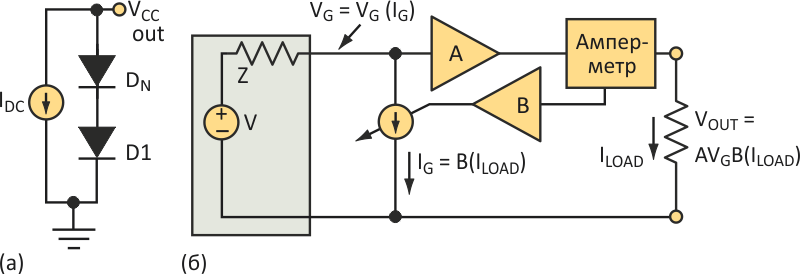This power supply may seem a bit strange, since it’s not stable in voltage or in current. However, it simulates the behavior of a solar panel and can be very useful if you’re working with a solar-powered device on a rainy day.
A solar-panel circuit can be represented by a current generator and some diodes (Fig. 1a). The short-circuit current depends on the cell type and illumination. The open circuit voltage depends on the number of cells. A simple way to “boost” a generator while maintaining its I-V characteristic uses a pair of op amps (Fig. 1b). You can tune the values of A and B to obtain the desired output with the I-V shape of the reference generator.
 |
||
| Figure 1. | The solar-panel equivalent circuit includes a constant-current generator (a). A pair of op amps boosts the generator current while maintaining the circuit’s I-V curve (b). |
|
The working simulator employs both these principles (Fig. 2). U1 acts as a current generator, and the constant current, flowing through a series of diodes (D1, D3, D5), is read at the shunt (R13). The diodes and the constant-current source constitute the reference generator (Fig. 1a, again). D2, D4, D6, and U2 perform temperature correction. U3 and Q1 comprise the output amplifier. Load current is read at the shunt, R14.
 |
||
| Figure 2. | The solar simulator uses a dc-dc converter in a 24-V floating power supply. LED D7 indicates whether the load is too weak, too heavy, or approaching the maximum power transfer. |
|
Both shunts (R13 and R14) work on the low side. This is not elegant, but since a solar panel is a floating device, the whole circuit must be powered with a floating voltage source, and the low-side shunts work perfectly. The circuit simulates the number of cells (open-circuit voltage) by changing the output gain by modifying R10’s value (Fig. 1b). R12 regulates the short-circuit current (IDC in Fig. 1a) by changing the B gain (Fig. 1b). Op amps aren’t critical, and many modern quad op amps can replace the old beloved LM741.
The circuit displays the power coupling conditions using LED D7. It lights green when the load is too weak, red when it’s too heavy, and orange when it approaches the maximum power transfer, indicating that the load is well coupled with the simulated panel. This is useful for quickly checking maximum power point tracking (MPPT) charge regulators.
The LED is operated by a couple of comparators (U4a and U4b), which look at the voltage of the series diodes. This is done after the thermal correction.
